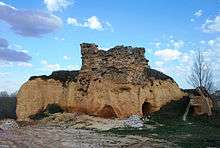Leonor Lasso de la Vega

Leonor Lasso de la Vega (b. before 1367 - d. 1432) was a Spanish noble woman from Cantabria and head of the prestigious House of Lasso de la Vega from 1367 - 1432.
Family Origins
Leonor was the paternal great-granddaughter of Garci Lasso de la Vega I, the chancellor of the Kingdom of Castile, who was executed in 1326 by order of King Alfonso XI of Castile, and his wife Juana de Castañeda. She was the paternal granddaughter of Garci Lasso de la Vega II, assassinated by Peter of Castile in 1351, who was the highest royal official to the court of Fadrique Alfonso de Castilla, son of King Alfonso XI of Castile, and his wife, Leonor González de Cornado. She was the only daughter of Garci Lasso Ruiz de la Vega, who spent his life in the service of Henry II of Castile and was killed at the Battle of Nájera in 1367 whereupon Leonor rose to the position of head of house.
Biography
She was a lifelong benefactor of the Monasterio de Santa Clara de Castrojeríz which was founded by her grandparents, Garci Lasso de la Vega II and Leonor González de Cornado.[1]
Marriage, Descendants and Legacy
Leonor's first marriage was with Juan Téllez de Castilla, the second lord of Aguilar de Campoo and the second lord of Castañeda. He was the son of Tello de Castilla who was in turn, the illegitimate son of Alfonso XI of Castile and Leonor de Guzmán. The couple had the following children:
- Aldonza Téllez de Castilla y de la Vega (b. 1382 - d. 1449), who married Garci IV Fernández Manrique de Lara. The couple went on to become the first Condes de Castañeda. Their offspring went on to found the Marquesado de Aguilar de Campoo, the Ducado de Galisteo and the Condado de Osorno.
When Tello died on August 14, 1385 at the Battle of Aljubarrota, Leonor remarried in 1387 with Diego Hurtado de Mendoza, High Admiral of Castile, bringing with her dowry, the title over the town of Carrión de los Condes and a manor at Asturias de Santillana. The two had the following children:
- García Lasso de la Vega, who according to his father's testamentary clauses had to change his name to Juan Hurtado de Mendoza.
- Elvira Laso de Mendoza, married Gómez I Suárez de Figueroa, first head of the House of Feria, son of Lorenzo I Suárez de Figueroa, Grand Master of the Order of Santiago. The couple were parents of, amongst others, Lorenzo II Suárez de Figueroa, first Conde de Feria.
- Íñigo López de Mendoza, 1st Marquis of Santillana, founder of the powerful Dukedom known as the Dukes of the Infantado and 1st Marquis of Santillana.
- Gonzalo Ruiz de Mendoza, whose grandmother, Mencía de Cisneros in her last will and testament of 1380 left him titles over Tierra de Campos and Vega with all its land and vassals.[2]
- Teresa de la Vega y Mendoza, married Álvaro Carrillo de Albornoz.
In August 1432,[3] Leonor empowered her children Íñigo, Gonzalo y Elvira to draft her last will and testament, by which process, her daughter from her first marriage, Aldonza was disinherited.
After her death, all her domains went to the House of Mendoza through Íñigo López de Mendoza. In 1445 King, John II of Castile confirmed this action by granting the title of Marquis of Santillana, where after Santillana del Mar which became the center of the lordship of Torrelavega in Cantabria.
The Cantabrian surname "Lasso de la Vega" was passed on through this maternal line at later times throughout the years and is associated with various soldiers, poets, and golden age writers such as Garcilaso de la Vega, the soldier and poet, and Inca Garcilaso, the historian from the Viceroyalty of Peru.
| Preceded by Garci Lasso Ruiz de la Vega |
Head of the House of Lasso de la Vega 1367–1432 |
Succeeded by Íñigo López de Mendoza |
References
- ↑ Real Academia de Historia, Colección Salazar y Castro, ref. M-19, fº 276v a 282: Marth 30th, 1420, Deed executed by Dona Leonor de la Vega, the wife of Diego Hurtado de Mendoza, granddaughter of Garcilasso de la Vega and Leonor de Cornado, founders of the Monastery of St. Clare of Castrojeriz, by which she donated to the monastery certain estates.
- ↑ Real Academia de Historia, Colección Salazar y Castro, ref. M-5, fº 282
- ↑ Real Academia de Historia, Colección Salazar y Castro, ref. M-1, fº 137
- The information on this page was mostly translated from its Spanish equivalent
Bibliography
Helen Nader, The Mendoza Family in the Spanish Renaissance (1350-1550)